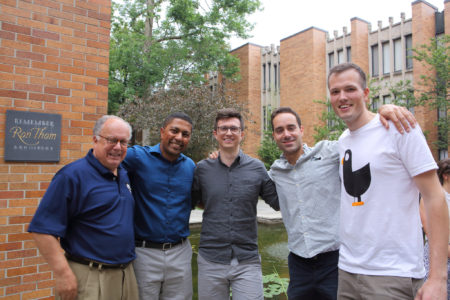Month: September 2016
Dakota Access Pipeline
One of North America’s most active pipeline resistance movements right now is opposing the Dakota Access Pipeline, which would run from North Dakota to Illinois through the Standing Rock Sioux reservation.
Some coverage:
- North Dakota oil pipeline protesters stand their ground: ‘This is sacred land’
- After Dakota pipeline battle, Indigenous people say they share “unprecedented unity”
- Bill McKibben: Hillary Clinton needs to take a stand on the Dakota Access Pipeline
- VIDEO: Dakota Access Pipeline Company Attacks Native American Protesters with Dogs and Pepper Spray
- Joint Statement from the Department of Justice, the Department of the Army and the Department of the Interior Regarding Standing Rock Sioux Tribe v. U.S. Army Corps of Engineers
John Fraser and Ron Thom
Canadian geographers divesting
In an encouraging step, the Canadian Association of Geographers has committed to divest from fossil fuels.
Future generations
The garbage can model – pertinent to activist organizations?
[James] March and his colleagues, Michael Cohen and Johan Olsen, developed an extremely important perspective on organizational behaviour, with the infelicitous title of the “garbage can model,” which seeks to explain how complex organizations make decisions under conditions that differ radically from those that reign under rational models. According to the model, such “organized anarchies” exhibit three general properties. First, instead of having clear and consistent objectives, “the organization operates on the basis of a variety of inconsistent and ill-defined preferences.” Different individuals at different levels of the organization may hold conflicting goals; the same individuals may hold different and incompatible goals at different times; organizations may not even know their preferences until after choices are made. Second, such organizations use extremely “unclear technology” in their operations: “Although the organization manages to survive and even product, its own processes are not understood by its members.” The organization’s left hand does not know what the right hand is doing; what happened in the past and why it happened is not clear; and the connections between the organization’s actions and the consequences of its actions are obscure. Third, there is extremely “fluid participation” in the organization’s decision-making process. Participants come and go; some pay attention, while others do not; key meetings may be dominated by biased, uninformed, or even uninterested personnel.
Sagan, Scott D. The Limits of Safety: Organizations, Accidents, and Nuclear Weapons. Princeton University Press. 1993. p. 29
Massey staff
Strategic Command and Control: Redefining the Nuclear Threat
Bruce Blair’s Strategic Command and Control: Redefining the Nuclear Threat (1985) effectively demolishes some of the core ideas in U.S. nuclear strategy. The book is largely focused on command, control, communications, and intelligence (C3I) and emphasizes how, while the U.S. raced ahead with developing vast numbers of nuclear weapon systems, it does not have a command and control infrastructure that is capable of functioning after being attacked. This makes notions of protracted nuclear war, ‘flexible response’, or negotiation while a nuclear war is ongoing seem entirely misguided. The ability to understand what is going on and exercise effective control over forces is certain to be degraded by everything from unintended strikes on C3I systems located near nuclear weapons, to the electromagnetic pulse effects of nuclear weapon detonation, to the destruction of RADAR systems, to the deliberate or collateral destruction of warning and communication satellites, to human errors and delays.
It’s obviously not the most up-to-date book, but it seems highly likely that most of the key arguments about the U.S. remain relevant. Between all the effects a series of nuclear strikes on the U.S. would have, it’s quite plausible that any ability to respond flexibly or continue to make sophisticated choices for days or weeks after the attack will be eliminated.
The issues discussed are also relevant in a world of nuclear proliferation. Politicians, military figures, and the public in all nuclear weapon states may systematically pay too much attention to the number and capability of nuclear weapon systems, while neglecting questions about the robustness of their command and control infrastructure and the plausibility of their doctrines for nuclear war fighting.
Green, white, and black
12 weeks of Hart House Judo
As a way to get more exercise and do something non-academic regularly, I signed up for 12 weeks of beginner Judo classes at Hart House. Classes are Tuesday evenings and early Saturday afternoons.
I’m excited to get into it, and glad I was able to snag one of the last three spots by rushing upstairs from tonight’s impressive demonstration of techniques.





